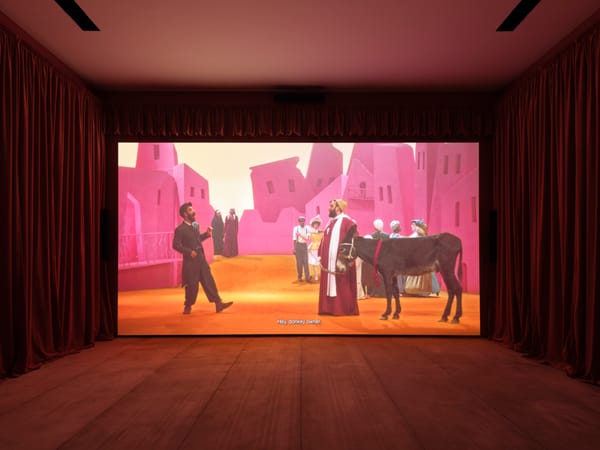Ideas
A Story of Qinglu Shanshui by Gu Wenda

On a sunny Saturday morning in September, I made my way over to the Shenzhen Convention and Exhibition Center to attend Gu Wenda’s large-scale, participatory performance A Story of Qinglu Shanshui, the second public contemporary art day (2016). The event, directed by Gu and backed by Ping An Financial Centre (PAFC Mall), was to include 1,500 volunteer children from Ping An Corporation’s remote area charitable schools. As I searched for the entrance to the hangar, where the event was to take place, I spotted some young students as they held their mothers’ hands. Following them into the hall, I saw the area had been prepared with neatly arranged rolls of large xuan paper. A pot with algae paint and a paintbrush marked each designated position for the students. One could oversee the entire setting from the hall’s high terrace, accessible by escalators, where spectators were invited to watch the performance.
Soon after entering and settling into their stations, the children grew restless, using their buckets and brushes as percussion instruments. They filled the hangar with their loud, excited drum rolls in anticipation. When Gu eventually allowed the children to crack the pots open and paint, the performative climax was palpable. Stick figures, animal forms and houses began to appear in green watercolor on the xuan paper. There was a shift of pace in the air as the paper became saturated with the algae, which, despite being food-grade and toxin-free, released a putrid odor. The more motivated painters continued smearing the now large puddles of green with one hand, while using the other to cover their mouths and noses with their custom-made T-shirts. Most remained unaware of what the green paint was, simply stating that it was “smelly,” and dropping their gear as they asked the accompanying adults if they could stop. In the center of these students was Gu, who with a giant brush on a large roll of paper created his calligraphy work titled Verdant Mountains, Emerald Waters (2016), part of his “Simplified Chinese Phrases” project (2005–). In this piece, Gu merged together the characters in the titular sentence—qingshan ("verdant mountain") and lushui ("emerald waters")—creating not only a new algae-ink scroll, but also new Chinese characters.

“In this work, I try to link to the Chinese day-to-day reality with a painting school called ‘qinglu shanshui.’ It is considered a [landscape] painterly school but not a scholarly one; people tend to look down on it and think of it as less intellectual and more colorful,” said Gu, when I talked to him later. The artist’s performance emerged from a concern about the overgrowing algae that pollutes fresh water in China and the world, and his aim to express these contemporary issues through Chinese landscape painting. “I am interested in health concerns in my daily life, since I set up my studio in China. I am not an environmentalist, but an artist who has the consciousness to improve things,” he explained of his choice of subject matter.
In what seems like a recurring impulse to share his work with younger generations, Gu previously included schoolchildren in another performance, Genetics & Metamorphosis, first public art day, which took place in May 2014 in Fo Shan, China. For this project, approximately 1,000 kids copied selections from Confucius's Classic of Filial Piety (4th century BC), transposing the text onto a 1,000-square-meter strip of red silk. The performance in Shenzhen was of equally large proportions; in this iteration, however, the kids were left free to draw or write whatever they liked. “For the kids, it is just about participating in a contemporary performance,” acknowledged the artist.
“Actually, using algae water to paint is not a new thing. In China and in the West, algae was used as a natural pigment before the invention of chemical colors. Much in the same way that fabric was dyed from natural plant dye, there was this tradition of using natural materials instead of toxic colors.” Gu explains that the most important aristic works, the ones that are everlasting, are reflective of their times. “You have to absorb and reflect the symbols from the times you live in,” he notes. Gu spent 32 years in China, where he was born, and then the subsequent 30 in the United States, and now splits his time between studios in both New York and Shanghai, literally embodying the often-overused concept of "East meets West."
After the performance I gazed at the scrolls left behind in the emptied convention center. The xuan paper was gorged with pools of fluids and doodles, and the arena looked like an artistic battlefield. Only the middle piece, where Gu had performed, had the harmonious, beautiful blue-green calligraphy. Although somehow disconnected, the children’s and Gu’s work bore the traces of an encounter—brief but intense.

To read more articles on Gu Wenda, go to our digital library: https://library.artasiapacific.com/







